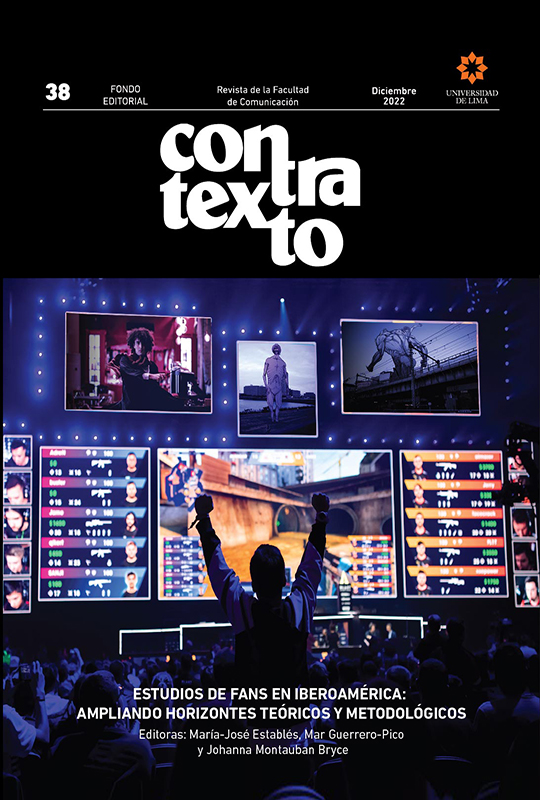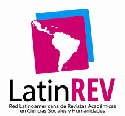Challenges of the disclosure of artificial intelligence in Spanish cybermedia
DOI:
https://doi.org/10.26439/contratexto2022.n038.5701Keywords:
journalism, artificial intelligence, media, technology, popular science, informationAbstract
The Digital Frontiers 2019 study, based on a survey of 1500 people, indicates that 62 % of the population consulted does not know what artificial intelligence (AI) is. Specifically, 60 % of respondents believe that AI is a robot. Given the importance of the media for scientific dissemination —according to a 2020 survey by the Spanish Science and Technology Foundation (FECYT), 61 % of Spaniards learn about science through digital media and social networks— we propose to analyze to what extent the contents of Spanish media on AI-related issues are rigorous, comprehensible and adequately explain the technological concepts. Methodologically, the study involves a content analysis of twenty news items published by Spanish-speaking digital media that include the term “artificial intelligence” and consulting ten press professionals about the dissemination of AI. The results indicate that in Spain, media coverage about AI and associated concepts shows an absence of easily comprehensible language for a wide and varied audience, a lack of connection with people’s daily lives, and a lack of depth in its approach to the subject.
Downloads
References
Allgaier, J., Sharon, D., Dominique, B., Lo, Yin-Yueh, & Peter, P. (2003). Journalism and social media as means of observing the contexts of science. BioScience, 284-287. https://doi.org/10.1525/bio.2013.63.4.8
Barrat, J. (2013). Our final invention: Artificial Intelligence and the end of the human era. Thomas Dunne Books. St. Martin Press.
Benítez de Gracia, M. J., & Herrera Damas, D. S. (2019). Realidad virtual y reportaje inmersivo con vídeo en 360º. Análisis del uso por parte de medios españoles. Miguel Hernández Communication Journal, 10(12). https://doi.org/10.21134/mhcj.v10i0.299
Bercovici, J. (2010). Can you tell a robot write this? Forbes. https://www.forbes.com/sites/jeffbercovici/2010/11/29/can-you-tell-a-robot-wrote-this-does-it-matter/ (Fecha de consulta: 31/03/2019).
Brennen, J. (2018). An industry-led debate: How UK media cover artificial intelligence. Reuters Institute for the Study of Journalism.
Bunz, M. (30 de marzo de 2010): “In the US, algorithms are already reporting the news”. The Guardian. https://www.theguardian.com/media/pda/2010/mar/30/digitalmedia-algorithms-reporting-journalism. (Fecha de consulta: 31/03/2019).
Burrell, J. (2016). How the machine “thinks”: Understanding opacity in machine learning algorithms. Big Data and Society, 3(1). https://doi.org/10.1177/2053951715622512
Calvo-Rubio, L. M., & Ufarte-Ruiz, M. J. (2020). Percepción de docentes universitarios, estudiantes, responsables de innovación y periodistas sobre el uso de inteligencia artificial en periodismo [Perception of University Teachers, Students, Innovation Managers and Journalists on the Use of Artificial Intelligence in Journalism]. El Profesional de la Información (EPI), 29(1). https://doi.org/10.3145/epi.2020.ene.09
Carlson, M. (2015) “The robotic reporter: Automated journalism and the redefinition of labor, compositional forms, and journalistic authority”. Digital Journalism, 3(3), 416-431. https://doi.org/10.1080/21670811.2014.976412
Caswell, D., & Dörr, K. (2018). Automated journalism 2.0: Event-driven narratives. Journalism Practice 12(4), 477-496. : http://dx.doi.org/10.1080/17512786.2017.1320773
Carnicero, J. (Coord.) (2002). Luces y sombras de la información de salud en Internet. [Lights and Shadows of Health Information on the Internet] (Informes SEIS, 4). Sociedad Española de Informática de la Salud. http://www.seis.es (Fecha de consulta: enero del 2021).
Clerwall, C. (2014). Enter the robot journalist. Journalism Practice, 8(5), 519-531. https://doi.org/10.1080/175127 86.2014.883116
Colegio Oficial de Ingenieros de Telecomunicación (COIT) – Asociación Española de Ingenieros de la Telecomunicación (AEIT) (2019). 5/5 Entrevista. Nuria Oliver nos cuenta su experiencia con la inteligencia artificial (IA) [Interview. Nuria Oliver Tells Us About her Experience with Artificial Intelligence (AI)]. https://www.youtube.com/watch?v=_iaKXMzHTXg&list=PLt4z7iBHtBU1A9PZIwqiNZKmyGRCw-S_&index=5 (Fecha de consulta: enero de 2021).
Colson, V. (2011). Science blogs as competing channels for the dissemination of science news. Journalism, 12(7): 889-902. https://doi.org/10.1177/1464884911412834
Corchete, S. H., & Anguiano, B. L. (2018). Los contenidos documentales de TVE de 1982 a 1990. [The documentary contents of TVE from 1982 to 1990]. En Una televisión con dos cadenas: la programación en España (1956-1990), pp. 741-760. Cátedra. https://revistas.usal.es/index.php/2172-9077/article/download/19557/19491 (Fecha de consulta: enero del 2021).
De Lara, A., & Del Campo Cañizares, E. (2018). El podcast como medio de divulgación científica y su capacidad para conectar con la audiencia. Revista Mediterránea de Comunicación, 9(1): 347-359. https://doi.org/10.14198/MEDCOM2018.9.1.15
De Lara, A., & García-Avilés, J. A. (2019). Estudio de la calidad del vídeo online en la comunicación de la ciencia. Perspectivas de la Comunicación, 12(1), 185-207. http://dx.doi.org/10.4067/S0718-48672019000100185
Fairfield, J., & Shtein, H. (2014). Big data, big problems: Emerging issues in the ethics of data science and journalism. Journal of Mass Media Ethics, 29(1), 38-51. https://doi.org/10.1080/08900523.2014.863126
Fernández Barrero, M. A. (2018). El periodismo que vuela. Drones, 3D, smartphones y robots, tecnologías emergentes para la profesión periodística. Fénix Editora.
Fundación Española Ciencia y Tecnología – FECYT (2020). Encuesta de Percepción Social de la Ciencia. https://www.fecyt.es/es/noticia/encuestas-de-percepcion-socialde-la-ciencia-y-la-tecnologia-en-espana (Fecha de consulta: abril 2022).
García Sastre, S., Idrissi-Ghlimi Cao, M., Ortega Arranz, A., & Gómez Sánchez, E. (2018). Uso de la colaboración y la gamificación en MOOC: un análisis exploratorio. Revista Latinoamericana de Educación a Distancia, 263-283. http://dx.doi.org/10.5944/ried.21.2.20410
Jeffs, T., & Smith, M. (Eds.) (1990). Using informal education: An alternative to casework, teaching, and control? Open University Press. https://doi.org/10.2307/3120884
Kaden, T., Jones S. H., & Catto, R. (2019). Language, labels and lived identity in debates about science, religion and belief. En Science, Belief and Society. University Press.
Karlsen, J., & Stavelin, E. (2014). Computational journalism in Norwegian newsrooms. Journalism Practice, 8(1), 34- 48. https://doi.org/10.1080/17512786.2013.813190
Krippendorff, K. (2013). Content analysis. An introduction to its methodology. Sage Publications, Inc.
Lemelshtrich, N. (2018). Robot journalism. Can human journalism survive? Centro Interdisciplinario Herzliya, WSPC.
León, B., & Bourk, M. (Eds.) (2018). Communicating science and technology through online video: Researching a new media phenomenon. Routledge. Taylor & Francis Group.
Linden, C. G. (2017). “Algorithms for journalism: The future of news work”. The Journal of Media Innovations, 4(1), 60-76. https://doi.org/10.5617/jmi.v4i1.2420.
López-Hermida, A., & Illanes, N. I. (2013). Nuevas narrativas en comunicación de salud: el storytelling y la conquista emocional del paciente [New narratives in health communication: Storytelling and the emotional conquest of the patient]. Anuario Electrónico de Estudios en Comunicación Social. Disertaciones, 6(2), 47-71.
Marcos. A. (2020). Información e inteligencia artificial [Information and Artificial Intelligence]. Ápeiron: Estudios de Filosofía, (12), 73-82. https://dialnet.unirioja.es/ servlet/articulo?codigo=7342984. (Fecha de consulta: enero del 2021).
Moreno, C. (2011). Periodismo y divulgación científica. Tendencias en el ámbito iberoamericano. Madrid: Biblioteca Nueva.
Moreno, P. S. (2019). El rigor informativo en la era de la posverdad: la amenaza de las fake news en las redes sociales [Informative rigor in the post-truth Era: The threat of fake news on social networks]. Comunicación y Hombre, (15), 55-66. 10.32466/eufv-cyh.2019.15.530.55-66
Muñoz Calvo, E. M., Muñoz Muñoz, L. M., García González, M. C., & Granado Labrada, L. A. (2013). La comprensión lectora de textos científicos en el proceso de enseñanzaaprendizaje [Reading comprehension of scientific texts in the teaching-learning process]. Humanidades Médicas, 13(3), 772-804. http://scielo.sld.cu/scielo.php?script=sci_arttext&pid=S1727-81202013000300013 (Fecha de consulta: enero del 2021).
Navas Navarro, S. (2016). Smart robots y otras máquinas inteligentes en nuestra vida cotidiana. Revista CESCO de Derecho de Consumo, 20. http://hdl.handle.net/10578/23525
Núñez, A. (2008). Será mejor que lo cuentes. Los relatos como herramientas de comunicación storytelling [You better tell it. Stories as communication tools storytelling] Empresa Activa.
Papadimitriou, A. (2016). The future of communication: Artificial intelligence and social networks. Media & Communication Studies. Mälmo University. https://muep.mau.se/bitstream/handle/2043/21302/The%20Future%20of%20 Communication.pdf?sequence=2
Rouhiainen, L. (2018). Inteligencia artificial. Alienta Editorial.
Rusell, S., & Norvig, P. (2003). Artificial intelligence. Pearson Education, Inc.
Sánchez, J. M. (2019). ¿La inteligencia artificial es un robot? Una gran mayoría de personas vive confundida [Is artificial intelligence a robot? A great majority of people live in confusion.]. ABC. https://www.abc.es/tecnologia/informatica/software/abci-inteligencia-artificial-robot-gran-mayoria-personas-viveconfundida-201907170131_noticia.html. (Fecha de consulta: enero del 2021).
Sancho Caparrini, F. (2018). Breve historia de la inteligencia artificial. Revista de Occidente. Fundación José Ortega y Gasset-Gregorio Marañón.
Sapien Aguilar, A. L., Valles Machuca, A., Piñón Howlet, L. C., & Gutiérrez Diez, M. D. C. (2019). Modelo estratégico de comunicación para el posicionamiento de universidades tecnológicas. Revista de Estudios y Experiencias en Educación, 18(38), 113-126. http://dx.doi.org/10.21703/rexe.20191838sapien7
Shao, C., Ciampaglia, G. L., Varol, O., Flammini, A., & Menczer, F. (2017). The spread of fake news by social bots. arXiv, 96(104). https://doi.org/10.1145/2872518.2890098
Tan, A. L., Jocz, J. A., & Zhai, J. (2017). Spiderman and science: How students’ perceptions of scientists are shaped by popular media. Public Understanding of Science, 26(5), 520-530. https://doi.org/10.1177/0963662515615086
Toharia, M. (2021). “La importancia de difundir la cultura científica”. En A. de Lara y A. Gómez (Eds.), Ciencia y periodismo. Una es de otra y otra es de Venus (pp. 88-89). XV Jornadas de Innovación en Periodismo 2019. Elche. Editorial UMH.
Torres Loaiza, J. E. (2004). El rigor: garantía para los periodistas, credibilidad para los medios y esperanza para los ciudadanos. Palabra Clave, 11(5). https://dialnet.unirioja.es/servlet/articulo?codigo=2106353
Túñez, J. M. (2021). Tendencias e impacto de la inteligencia artificial en comunicación: cobotización, gig economy, co-creación y gobernanza. Fonseca, Journal of Communication, (22). https://doi.org/10.14201/fjc-v22-25766
Túñez, J. M., Toural, C., & Cacheiro, S. (2018). “Uso de bots y algoritmos para automatizar la redacción de noticias: percepción y actitudes de los periodistas en España”. El Profesional de la Información, 27(4), 750-758. https://doi.org/10.3145/epi.2018.jul.04
Valles, M. (2014). Cuadernos Metodológicos, 32. Entrevistas cualitativas. Centro de Investigaciones Sociológicas.
Weeks, L. (2014). Media law and copyright implications of automated journalism. Journal of Intellectual Property and Entertainment Law, 4(1), 67-94. New York University. https://jipel.law.nyu.edu/wp-content/uploads/2015/05/NYU_JIPEL_Vol-4-No-1_3_Weeks_MediaLawAndCopyrightImplicationsOfAutomatedJournalism.pdf (Fecha de consulta: enero del 2021).
Weigold, M. F., & Treise, D. (2004). Attracting teen surfers to science websites. PublicUnderstanding of Science, 13(3), 229-248. https://doi.org/10.1177/0963662504045504
World Health Organization (2017). WHO strategic communications framework for effective communications. WHO. https://www.who.int/mediacentre/communication-framework.pdf (Fecha de consulta: enero del 2021).
World Health Organization (2020). Disease outbreaks. https://www.who.int/emergencies/diseases/en (Fecha de consulta: enero del 2021).
Downloads
Published
Issue
Section
License
All of the works published are licensed under a CC BY 4.0 Creative Commons Attribution license. (updated on March 1st 2021)
The content of the journal may be shared in any material or format. The content may be adapted, contributed upon and transformed. Both possibilities are only permitted in so far as they complete the following conditions:
- Attribution: Credit must be given where it is due, a link to the license must be provided and changes, if made, must be indicated. This should be done in the manner deemed appropriate, without suggesting that the licensor promotes you or your use of the material.
Ownership rights
The patrimonial rights for Contratexto are published under a Creative Commons BY 4.0 license, allowing authors to keep the patrimonial rights to their work without restrictions.
If a work published in Contratexto were to be copied, distributed, spread, or any other activities contemplated in the aforementioned license, the author(s) and the journal must be mentioned visibly and expressly.
Self-archive
This journal allows and encourages authors to post items submitted to the journal on personal websites or institutional repositories both prior to and after publication, while providing bibliographic details that credit, if applicable, its publication in this journal.

















